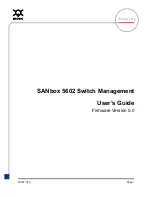
Spanning Tree
51
If you modify any MSTP port settings, click
Apply
to save the changes for the current boot session.
The changes take effect immediately but are not retained across a switch reset unless you click
Save
Configuration
.
Port Priority
The priority for the port within the MSTI. This value is used in determining which port on a
switch becomes the root port when two ports have the same least-cost path to the root. The
port with the lower priority value becomes the root port. If the priority values are the same, the
port with the lower interface index becomes the root port.
Port Path Cost
The path cost from the port to the root bridge.
Auto-calculate Port Path
Cost
Shows whether the path cost from the port to the root bridge is automatically determined by
the speed of the interface (Enabled) or configured manually (Disabled).
Port ID
A unique value that is automatically generated based on the port priority value and the
interface index.
Port Up Time Since
Counters Last Cleared
The amount of time that the port has been up since the counters were cleared.
Port Mode
The administrative mode of spanning tree on the port.
Port Forwarding State
Blocking – The port discards user traffic and receives, but does not send, BPDUs. During
the election process, all ports are in the blocking state. The port is blocked to prevent
network loops.
Listening – The port sends and receives BPDUs and evaluates information to provide a
loop-free topology. This state occurs during network convergence and is the first state in
transitioning to the forwarding state.
Learning – The port learns the MAC addresses of frames it receives and begins to popu-
late the MAC address table. This state occurs during network convergence and is the
second state in transitioning to the forwarding state.
Forwarding – The port sends and receives user traffic.
Disabled – The port is administratively disabled and is not part of the spanning tree.
Port Role
The role of the port within the MST, which is one of the following:
Root – A port on the non-root bridge that has the least-cost path to the root bridge.
Designated – A port that has the least-cost path to the root bridge on its segment.
Alternate – A blocked port that has an alternate path to the root bridge.
Backup – A blocked port that has a redundant path to the same network segment as
another port on the bridge.
Master – The port on a bridge within an MST instance that links the MST instance to
other STP regions.
Disabled – The port is administratively disabled and is not part of the spanning tree.
Designated Root
The bridge ID of the root bridge for the MST instance.
Designated Cost
The path cost offered to the LAN by the designated port.
Designated Bridge
The bridge ID of the bridge with the designated port.
Designated Port
The port ID of the designated port.
Loop Inconsistent State
Identifies whether the interface is currently in a loop inconsistent state. An interface
transitions to a loop inconsistent state if loop guard is enabled and the port stops receiving
BPDUs. In this state, the interface does not transmit frames.
Transitions Into
LoopInconsistent State
The number of times this interface has transitioned into loop inconsistent state.
Transitions Out Of
LoopInconsistent State
The number of times this interface has transitioned out of loop inconsistent state.
Field
Description
















































